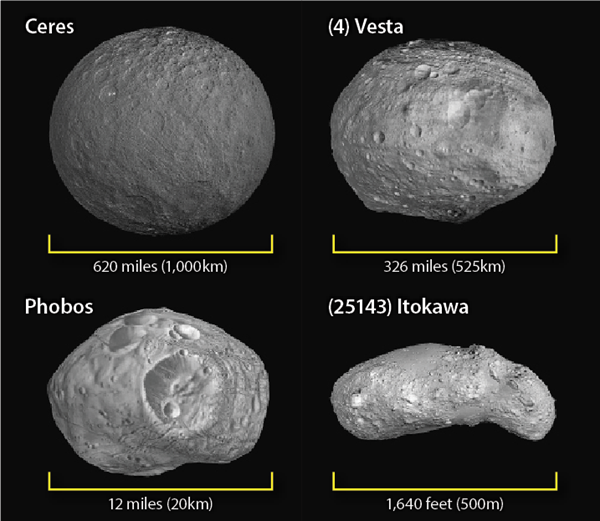Key Takeaways:
Q: What is the diameter of a body with just enough mass to pull itself into a sphere? How big are the smallest spherical bodies in our solar system?
Paul Kendelman
Pennsville, New Jersey
A: The solar system contains hundreds of thousands of small bodies larger than a few kilometers in size. Many are in the main asteroid belt, which contains the fragmentary remnants of planetesimals, small bodies from which the planets formed. A few have survived nearly intact. Most asteroids are irregular in shape; however, Ceres, the main belt’s largest body and the smallest dwarf planet, is round. The smallest round bodies may be found among the icy moons of Saturn or in the outer solar system.
Roundness requires hydrostatic equilibrium, which is one of the criteria used by the International Astronomical Union to define a planet or dwarf planet. When subjected to self-gravity, a rotating fluid will relax to a round (ellipsoidal) shape. Solids (rigid bodies) resist changes in shape, but when stresses are large enough, they deform, fracture, and flow. For massive objects, gravitational and rotational forces overcome rigid body forces, resulting in round bodies with low topographic relief.
Planetesimals that formed close to the Sun incorporated little water and condensed largely from silicate grains containing short-lived radionuclides such as aluminum-26, which originated from a nearby supernova. The heat produced by radioactive decay may have been sufficient to melt bodies as small as 62 miles (100 kilometers) in diameter. Imagine a massive, round blob of molten rock — as heating abated, these bodies solidified to form an iron-rich core, silicate mantle, and basaltic crust.
For these igneous planetesimals, the diameter needed to overcome rigid body forces and become round is about 620 miles (1,000km). The main belt asteroid Vesta is 326 miles (525km) in diameter. In its early history, Vesta’s interior was at least partially molten and may at one time have been in hydrostatic equilibrium; however, after cooling, Vesta was battered out of round by large impacts.
Farther from the Sun, ice condensed along with silicate grains to form planetesimals consisting of a fragile mixture of ice and rock. The minimum diameter to achieve hydrostatic equilibrium for an icy body is comparatively small, about 310 miles (500km).
Due to rotational forces, icy Ceres (620 miles [1,000km] in diameter) is an oblate (flattened) spheroid. Some smaller bodies in the outer solar system, such as the trans-Neptunian object Huya (310 miles [500km] in diameter), appear to be round and may also be in hydrostatic equilibrium.
Senior Scientist, Planetary Science Institute,
Albuquerque, New Mexico










